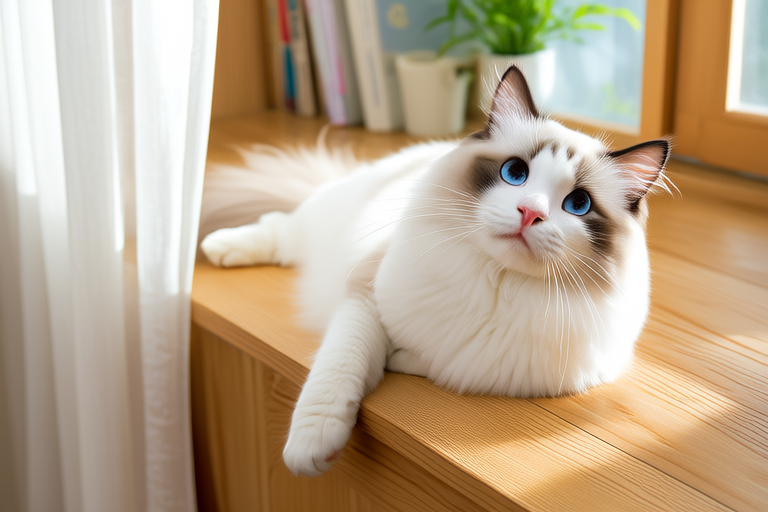The Gentle Ragdoll Cat: A Comprehensive Guide
The Ragdoll is one of the most beloved cat breeds in the world, known for its gentle nature and affectionate demeanor. This article delves into the unique traits, history, and care tips for Ragdolls, providing an all-encompassing look at this charming breed.
A Gentle Giant with a Soft Heart
The Ragdoll is often referred to as the “dog of cats” due to its friendly and docile personality. These cats are renowned for their calm and relaxed disposition, making them perfect companions for families, especially those with children or other pets. Their large size, typically weighing between 8 to 20 pounds, adds to their gentle giant appeal. Despite their robust build, Ragdolls are incredibly graceful and agile, capable of leaping and playing with ease.
One of the most distinctive features of the Ragdoll is its semi-long coat, which requires regular grooming to prevent matting. The coat’s texture is soft and silky, and it comes in a variety of colors and patterns, including seal, blue, chocolate, lilac, cream, red, and tortoiseshell. The Ragdoll’s striking blue eyes add to its enchanting appearance, giving it a mesmerizing gaze that captivates anyone who meets it.
A Fascinating History and Origin
The Ragdoll’s origins can be traced back to the mid-20th century in California, where a breeder named Ann Baker crossed a Persian-like longhaired white female cat with a male Birman or Burmese cat. The resulting offspring were selectively bred to produce the Ragdoll we know today. In the 1960s, Ann Baker began breeding these cats and developed the Ragdoll breed.
The name “Ragdoll” was inspired by the cat’s tendency to go limp when picked up, similar to a rag doll. This trait, along with their docile nature, has endeared them to many cat lovers around the world. The breed was officially recognized by The International Cat Association (TICA) in 1994 and by the Cat Fanciers’ Association (CFA) in 2000.
Behavior, Intelligence, and Compatibility
Ragdolls are highly intelligent and trainable cats, capable of learning tricks such as fetching toys and walking on a leash. They are also known for their loyalty and attachment to their owners, often following them from room to room. Ragdolls are social creatures that thrive on human interaction and companionship, making them excellent companions for individuals living alone or in families.
These cats are generally good with children and other pets, provided they are introduced properly. Their calm and patient nature makes them tolerant of children’s playful antics, and they can coexist peacefully with other animals, including dogs. However, early socialization is essential to ensure a harmonious household.
Care Tips and Common Health Issues
Grooming is an important aspect of caring for a Ragdoll. Their semi-long coat requires weekly brushing to prevent matting and tangling. Bathing may be necessary occasionally, especially if the cat gets into something messy. Regular nail trimming, ear cleaning, and dental hygiene are also crucial for maintaining their overall health.
Ragdolls are generally healthy cats, but like all breeds, they are prone to certain health issues. Hypertrophic cardiomyopathy (HCM), a form of heart disease, is one of the most common conditions affecting Ragdolls. Regular veterinary check-ups and early detection are key to managing this condition. Other potential health concerns include polycystic kidney disease (PKD), which can lead to kidney failure, and hip dysplasia, a condition that affects the hip joint.
Why the Ragdoll is Often Considered an Ideal Companion
The Ragdoll’s gentle nature, intelligence, and adaptability make it an ideal companion for many households. Their calm demeanor and affectionate personality create a peaceful and loving environment for their owners. Ragdolls are known for their loyalty and attachment, forming strong bonds with their human families.
Despite their large size, Ragdolls are relatively low-maintenance compared to some other breeds. Their calm and easy-going nature means they are content with indoor living, making them suitable for apartment dwellers. Ragdolls are also adaptable to different environments, whether it’s a bustling city home or a quiet rural setting.
Interesting Fact: Ragdolls have a unique trait called “glue ears,” where their earwax is unusually thick and sticky. This can lead to wax buildup and potential hearing problems if not managed properly. Regular ear cleaning is recommended to prevent any issues.
Conclusion
The Ragdoll is a truly remarkable cat breed, combining beauty, intelligence, and affection in a package that makes it an ideal companion for many households. Its gentle nature, loyalty, and adaptability make it a cherished member of families worldwide. By understanding the breed’s unique characteristics and providing proper care, owners can enjoy a lifetime of love and companionship with their Ragdoll cat.
